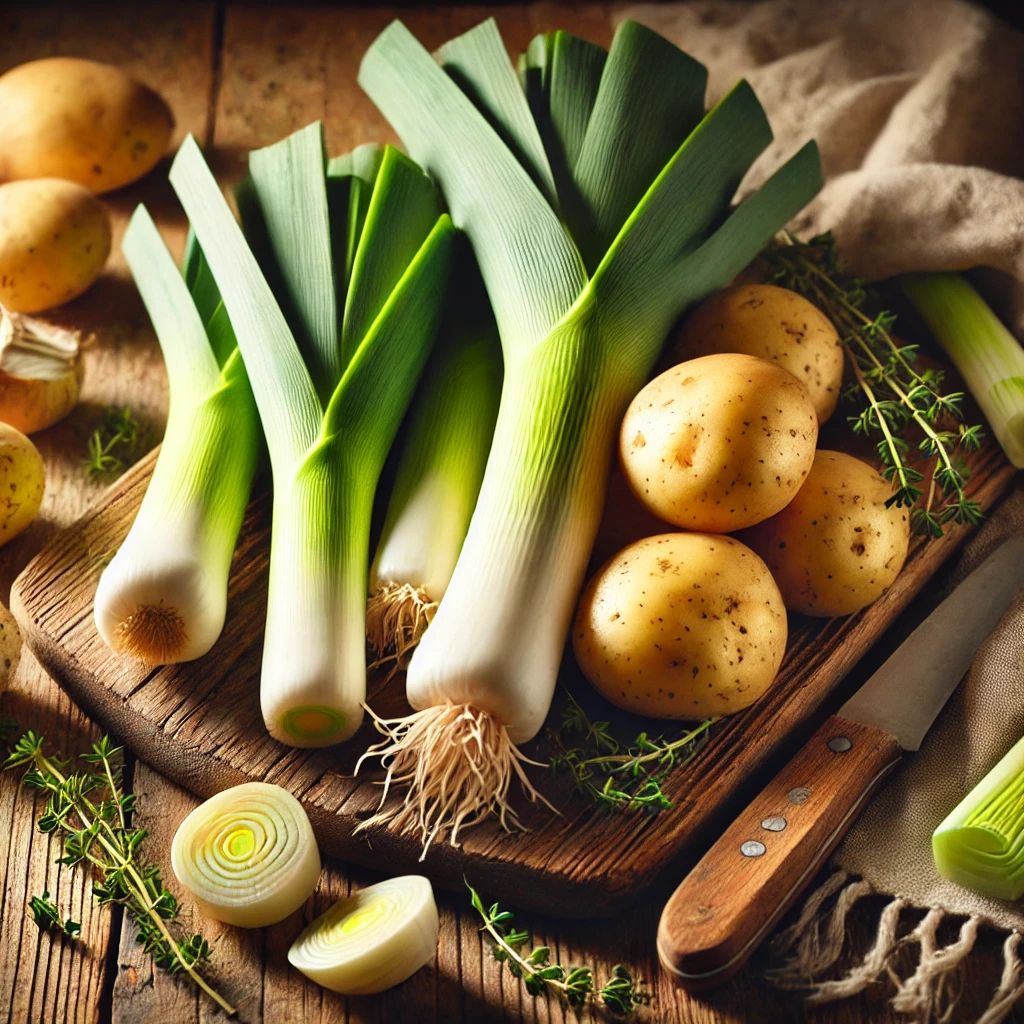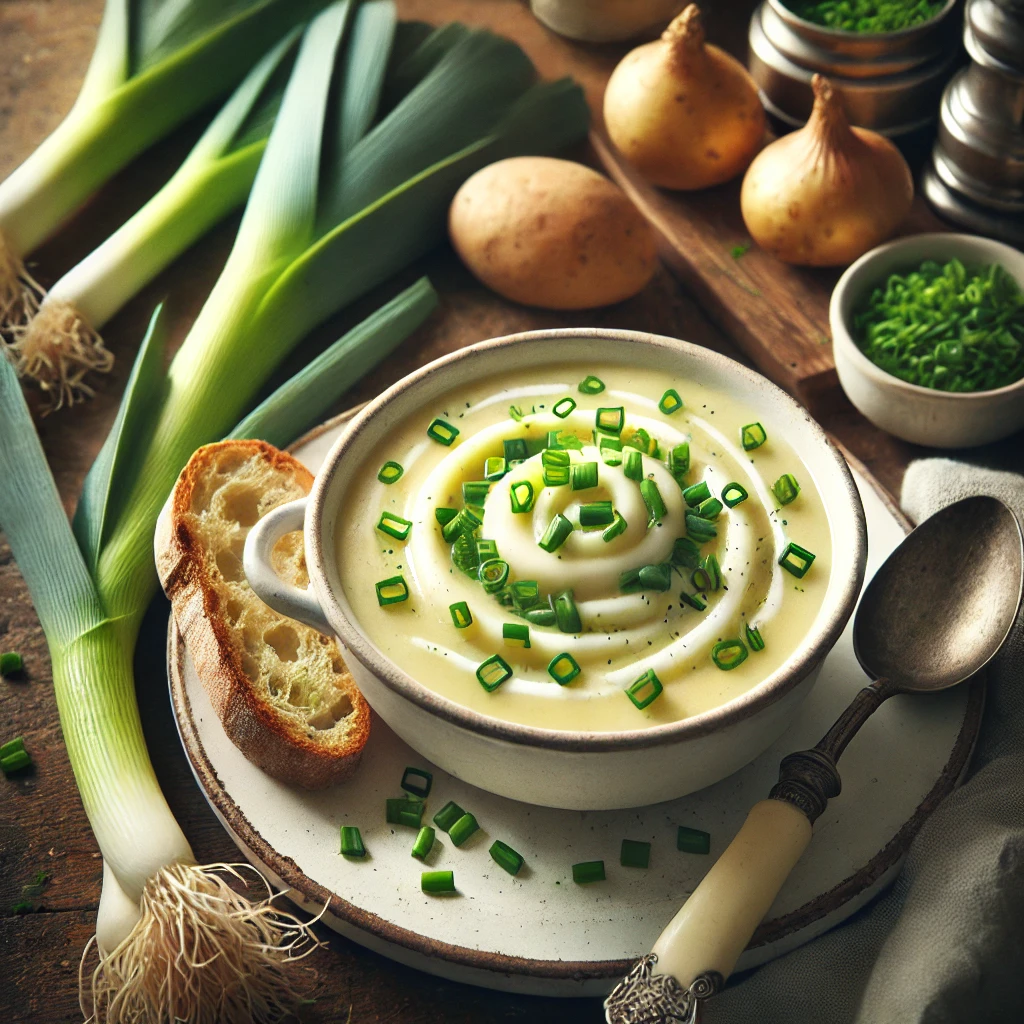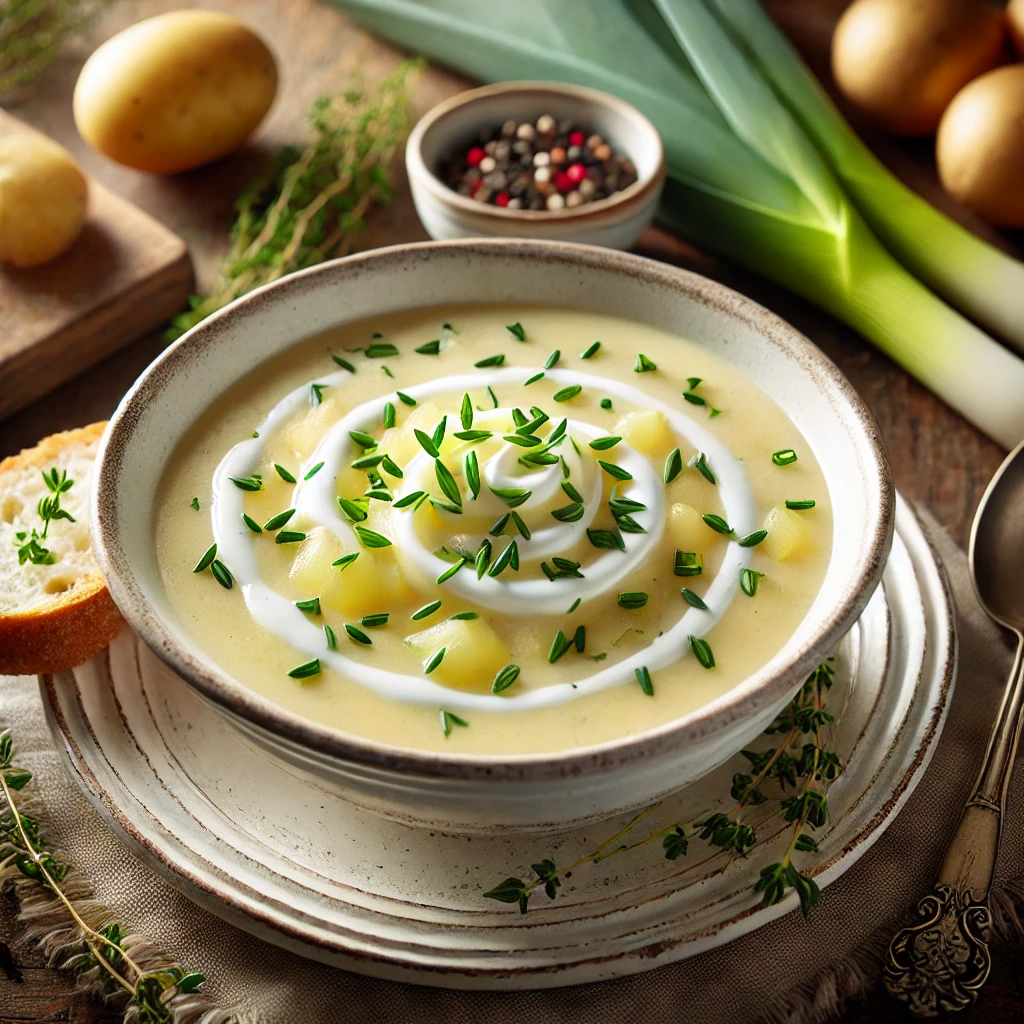Julia Child, the culinary legend who introduced French cooking to America, was a lover of simple yet elegant cuisine. Her approach to food was about celebrating flavors, techniques, and the joy of cooking. Among her many culinary masterpieces, one soup often stands out as her favorite: Potage Parmentier, a classic French potato and leek soup.
In this article, we’ll explore why this humble soup captured Julia Child’s heart, provide insights into her recipe, and delve into what makes it so timeless.
Table of Contents
ToggleJulia Child’s Love for Potage Parmentier
Potage Parmentier is a simple soup made with potatoes, leeks, and a few other basic ingredients. Julia Child featured this dish in her iconic cookbook, Mastering the Art of French Cooking. Despite its simplicity, this soup embodies the principles she cherished: using quality ingredients, embracing traditional techniques, and creating dishes with incredible flavor.
Why Was Potage Parmentier Her Favorite?
- Simplicity with Elegance:
- The soup relies on basic ingredients but achieves a rich and velvety texture, demonstrating that excellent cooking doesn’t have to be complicated.
- Versatility:
- It can be served hot or cold, making it suitable for all seasons. The chilled version, known as Vichyssoise, was another favorite of Julia’s.
- Nostalgic Appeal:
- Potage Parmentier reflects Julia’s passion for rustic, home-cooked meals and her dedication to making French cuisine accessible.
Potage Parmentier Recipe: Julia Child’s Way
Let’s break down Julia Child’s recipe for this iconic soup.

Ingredients
- Potatoes: 1 pound (russet or Yukon gold preferred)
- Leeks: 3 medium-sized leeks, white and light green parts only
- Water or Stock: 4 cups (water for simplicity or chicken stock for added flavor)
- Salt: 1 teaspoon
- Butter: 2 tablespoons
- Cream (optional): ½ cup for a richer texture
- Chives (optional): Finely chopped, for garnish
Instructions
- Prepare the Vegetables:
- Peel and dice the potatoes into small chunks.
- Slice the leeks thinly and rinse thoroughly to remove dirt and grit.
- Cook the Base:
- In a large pot, combine the potatoes, leeks, water (or stock), and salt.
- Bring to a simmer over medium heat.
- Cook uncovered for about 30–40 minutes, or until the vegetables are very tender.
- Blend the Soup:
- Use an immersion blender or a countertop blender to puree the soup until smooth.
- Alternatively, mash the vegetables with a potato masher for a rustic texture.
- Finish with Butter and Cream:
- Stir in the butter until melted. If desired, add cream for a silkier consistency.
- Serve and Garnish:
- Ladle the soup into bowls and garnish with chopped chives.
Vichyssoise: The Chilled Variation
Julia Child was also a fan of Vichyssoise, a cold variation of potato and leek soup. The preparation is nearly identical to Potage Parmentier, with the addition of heavy cream and chilling the soup before serving. This dish is refreshing and perfect for warm weather, making it a favorite during summer.
Why Potage Parmentier is Timeless
Potage Parmentier remains beloved not just for its simplicity but for its adaptability and comforting nature. Julia Child’s version highlights:
- Accessibility: With just a few ingredients, it’s affordable and easy to prepare.
- Customizability: Add garlic, onions, or even a dash of nutmeg for unique twists.
- Comfort: Its creamy texture and mild flavors make it the ultimate comfort food.
Tips for Perfecting Potage Parmentier
- Choose the Right Potatoes:
- Use starchy potatoes like russets for a smooth soup, or waxy potatoes for a heartier texture.
- Thoroughly Clean Leeks:
- Dirt often hides between leek layers, so rinse them well after slicing.
- Season Generously:
- Potatoes can absorb a lot of salt, so taste and adjust as needed.
- Blend Carefully:
- Use an immersion blender for a seamless process, or let the soup cool slightly before blending in a countertop blender.
- Experiment with Toppings:
- Beyond chives, try crispy bacon bits, croutons, or a drizzle of truffle oil for added flair.
Frequently Asked Questions
- What made Julia Child love Potage Parmentier?
- Its simplicity, versatility, and the way it captures the essence of French home cooking.
- Can Potage Parmentier be made vegan?
- Yes, substitute butter with olive oil and cream with a plant-based alternative like coconut milk.
- What’s the difference between Potage Parmentier and Vichyssoise?
- Potage Parmentier is served hot, while Vichyssoise is served chilled with additional cream.
- Can I freeze Potage Parmentier?
- Absolutely! Let the soup cool completely before freezing it in airtight containers.
- What’s the ideal texture for this soup?
- It can be silky smooth or slightly chunky, depending on your preference.
- Can I add other vegetables to the soup?
- Yes, onions, celery, or parsnips make great additions for added complexity.
- What type of stock is best for Potage Parmentier?
- Chicken stock adds depth, but vegetable stock works well for vegetarian versions.
- How long does it take to make Potage Parmentier?
- From start to finish, it typically takes about 45–50 minutes.
- Can I use other herbs besides chives?
- Yes, parsley, dill, or thyme are excellent alternatives.
- Why is Potage Parmentier considered a French classic?
- Its origins, simplicity, and reliance on fresh ingredients reflect the essence of French country cooking.
Julia Child’s love for Potage Parmentier reminds us that even the simplest dishes can be exquisite when prepared with care and attention. This timeless soup continues to inspire cooks worldwide, showcasing that with a handful of ingredients, you can create something truly extraordinary.
The Origins of Potage Parmentier
Potage Parmentier is named after Antoine-Augustin Parmentier, a French pharmacist and nutritionist who championed the potato in France during the 18th century. At the time, potatoes were regarded with suspicion, thought to cause diseases, and were even banned in some regions. Parmentier tirelessly promoted potatoes as a nutritious and affordable staple food, revolutionizing French cuisine.
This soup pays homage to Parmentier’s efforts and highlights the humble potato as a cornerstone of French culinary tradition. Julia Child’s love for this dish reflects her respect for traditional French cooking and her ability to celebrate even the simplest ingredients.
Julia Child’s Philosophy: Elevating the Everyday
Julia Child’s approach to cooking was about more than just food—it was a celebration of life, flavors, and the joy of creating something extraordinary from ordinary ingredients. Potage Parmentier epitomizes this philosophy:
- Ingredient-Focused Cooking: Using simple ingredients and letting their natural flavors shine.
- Comfort Food with a Gourmet Twist: Turning basic potatoes and leeks into a silky, comforting masterpiece.
- Accessible for All Skill Levels: Whether you’re a beginner or an expert, Potage Parmentier is foolproof.
Julia Child’s Variations of Potato and Leek Soup
While the classic recipe remains a favorite, Julia often suggested ways to personalize and enhance the soup:
- Add Bacon or Ham: For a smoky, savory flavor, sauté diced bacon or ham with the leeks.
- Incorporate Herbs: Fresh thyme or a bay leaf simmered with the soup adds depth and complexity.
- Spice It Up: A pinch of nutmeg or white pepper can elevate the soup’s flavor profile.
- Make It Creamier: Blend in crème fraîche or sour cream for a tangy richness.
- Rustic Touch: Skip the blending step and serve the soup chunky for a hearty, farmhouse feel.

Cultural Significance of Potage Parmentier
Potage Parmentier isn’t just a dish; it’s a symbol of French culinary culture:
- Peasant Roots: Like many French classics, this soup originated as a simple peasant dish made with inexpensive, readily available ingredients.
- Culinary Icon: Over time, it has been elevated to a dish served in fine dining establishments, embodying the “high-low” charm of French cuisine.
- Seasonal Versatility: Served hot in winter as Potage Parmentier or chilled in summer as Vichyssoise, the dish remains relevant year-round.
How to Make Potage Parmentier Your Own
One of the reasons Julia Child adored this soup was its adaptability. Here are some ways to personalize it based on your tastes and preferences:
1. Create a Fusion Twist
Incorporate flavors from other cuisines:
- Add ginger and lemongrass for an Asian-inspired twist.
- Blend in roasted garlic and Parmesan for an Italian flair.
- Use cumin and coriander for a hint of Middle Eastern flavor.
2. Boost the Nutrition
Transform the dish into a nutrient-packed meal by adding:
- Spinach or kale during the last 10 minutes of cooking.
- A handful of lentils or quinoa for protein and fiber.
- Sweet potatoes in place of regular potatoes for added vitamins and a slightly sweeter taste.
3. Enhance Presentation
Turn Potage Parmentier into a visually stunning dish:
- Swirl a drizzle of olive oil or cream on top.
- Garnish with edible flowers or microgreens for a gourmet touch.
- Serve in a hollowed-out bread bowl for rustic charm.
Famous Quotes by Julia Child About Soup
Julia Child often emphasized her love for hearty, homey meals, and her enthusiasm for soup shines in her quotes:
- “A first-rate soup is more creative than a second-rate painting.”
- “Soup is the song of the hearth… and the soul.”
These quotes capture the essence of Julia’s passion for dishes like Potage Parmentier, which are both nourishing and inspiring.
Potage Parmentier in Modern Cuisine
Potage Parmentier has stood the test of time and continues to inspire chefs and home cooks worldwide. Here’s why it remains relevant today:
- Farm-to-Table Movement: The focus on fresh, local ingredients aligns perfectly with the soup’s simplicity.
- Plant-Based Trends: The dish can be easily adapted for vegan diets without losing its essence.
- Budget-Friendly Cooking: In times of rising food costs, this soup is an affordable and satisfying option.
A Personal Reflection on Julia Child’s Favorite Soup
Julia Child’s love for Potage Parmentier reminds us that food doesn’t need to be extravagant to be memorable. Her infectious joy in preparing even the simplest dishes inspires us to embrace cooking with creativity and enthusiasm. This soup, with its roots in French tradition and its universal appeal, embodies everything Julia stood for: good food, made with love, and shared with those around us.

